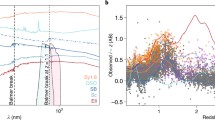Abstract
Photometry is used as a cheap and easy way to estimate redshifts of galaxies, which would otherwise require considerable amounts of expensive telescope time. However, the analysis of photometric redshift datasets is a task where it is sometimes difficultto achievea high classification accuracy. This work presents a custom Genetic Algorithm (GA) for mining the Hubble Deep Field North (HDF-N) datasets to achieve accurate IF-THEN classification rules. This kind of knowledge representation has the advantage of being intuitively comprehensible to the user, facilitating astronomers’ interpretation of discovered knowledge. The GA is tested againstthe state of the art decision tree algorithm C5.0 [Rulequest, 2005] in two datasets, achieving better classification accuracy and simplerrule sets in both datasets.
Access this chapter
Tax calculation will be finalised at checkout
Purchases are for personal use only
Preview
Unable to display preview. Download preview PDF.
Similar content being viewed by others
References
Appenzeller, I. FORS consortium; The FORS Deep Field (FDF) [http://www.lsw.uni-heidelberg.de/users/jheidt/fdf/fdf.html], Visited October 2005
Bolnzella, M. et al. Photometric redshifts based on standard SED fitting procedures, Astron. Astrophys. 363, 476–492, 2000
Bowman, B. et al. Reasoning about naming systems. ACM Trans. Program. Lang. Syst., 15, 5 (Nov. 1993), 795–825, 1993.
Collister, A. A., Lahav, O. ANNz: estimating photometric redshifts using artificial neural networks, astro-ph, 0311058, 2003
Connolly, A.J. et al, Slicing Through Multicolor Space: Galaxy Redshifts from Broadband Photometry, astro-ph/9508100, 1995
Cowie L.L. et al. A large sample of spectroscopic redshifts in the ACS-GOODS region of the HDF-N, astro-ph/0401354, 2004
D’Odorico et al. European Space Agency; The NTT SUSI Deep Field [http://www.eso.org/science/ndf/], Visited October 2005
Daddi et al., The Population of BzK Selected ULIRGs at z≈2, astro-ph/0507504vl, 2005
Daddi et al., Star-formingand Passive Galaxies, ApJ, 617, 746, 2004
Ding, W., Marchionini, G. A Study on Video Browsing Strategies. Technical Report UMIACS-TR-97-40, University of Maryland, College Park, MD, 1997.
ESO Education & Public Relations Department. Deep Galaxy Counts and Photometric Redshifts in the HDF-S NIC3 Field [http://www.eso.org/outreach/press-rel/pr-1998/pr-20-98.html], 1998, Visited on 15 August 2004
ESO Education & Public Relations Department. The FORS/ISAAC Cluster Deep Field [http://www.eso.org/outreach/press-rel/pr-1999/phot-0999. html], 1999, Visited on 15 August 2004
Falkenauer E., The Worth of the Uniform, CEC-99, 1999
Fayyad U. M., Chapter 19: Automating the Analysis and Cataloging of Sky Surveys, Advances in Knowledge Discovery and Data Mining, AAAI Press/The MIT Press, 1996
Ferguson H., Space Telescope Science Institute. The Hubble Deep Field [http://www.stscLedu/ftp/science/hdf/hdf.html], Visited October 2005
Femandez-Soto A. et al. A new catalog of photometric redshifts in the Hubble Deep Field, Astrophys. J., 513, 34–50, 1999
Freitas A. Data Mining and Knowledge Discovery with Evolutionary Algorithms, Springer, 2002
Giavalisco M. et al. The Hubble Deep Field: Number Counts, Color-Magnitude and Color-Color Diagrams, 1997
Gwyn, S., The Redshift Distribution and Luminosity Functions, astro-ph/9603149, 1996
Kwedlo W., Kretowski M. An Evolutionary Algorithm Using Multivariate Discretization for Decision Rule Induction, Proceedings of Evolutionary Computations on Principles of Data Mining and Knowledge Discovery (PKDD’00), Springer LNCS 1910, 2000
Kwedlo W., Kretowski M. Discovery of decision rules from databases: an evolutionary approach. Principles of Data Mining and Knowledge Discovery, PKDD’98. Nantes, France. Springer LNCS 1510, 1998
Lahav O. et al. Neural Computation as a tool for galaxy classification: methods and examples, MNRAS, 283, 207L, 1996
Peacock J. A. Cosmological Physics, Cambridge University Press, 1999
Rengelink R. AXAF Field: Deep Optical-Infrared Observations, Data Reduction and Photometry, ESO Imaging Survey, 1998
Rulequest Research. Data Mining Tools See 5 and C5.0 [http://www.rulequest.com/see5-info.html]. 2005, Visited on October 2005
Richmond, M., Photometric Systems and Colors [http://spiff.rit.edu/classes/phys445/lectures/colors/colors.html], Visited on October 2005
Stanway E. R. et al. Lyman Break Galaxies andthe Star Formation Rate of the Universe at z≈6, 2003
Stanek, R., Photometry [http://astrwww.astr.cwru.edu/nassau/reference/photometry.html], CWRU Astronomy Dept, 1999, Visited onOctober 2005
Steidel C. C., Hamilton D. Deep imaging of high redshift QSO fields below the Lyman limit. I — The field of Q0000-263 and galaxies at Z=3.4, AJ, 104, 941–949, 1992
Steidel C. C. et al. Lyman Imaging of High-Redshift Galaxies.IlI.New Observations of Four QSO Fields, AJ, 110, 2519, 1995
Steidel C. C. et al. Spectroscopic Confirmation of a Population of NormalStar-forming Galaxies at redshifts z>3, AJ, 462, L17–L21, 1996
Syswerda G., Uniform Crossover in Genetic Algorithms, ICGA-89, 1989
Wang et al. A Catalog of Color-based Redshift Estimates for Z<≈4 Galaxies in the Hubble Deep Field, AJ 116, 2081, 1998
Williams R. et al. The Hubble Deep Field: Images, 1997
Wirth G. et al. The Team Keck Treasury Redshift Survey of the GOODS-North Field, astro-ph/0401353, 2004
Witten I. H., Frank E. Data Mining — PracticalMachine Learning Tools and Techniques with Java Implementations, Morgan Kaufmann, 2000
Author information
Authors and Affiliations
Editor information
Editors and Affiliations
Rights and permissions
Copyright information
© 2007 Springer-Verlag London Limited
About this paper
Cite this paper
Miles, N., Freitas, A., Serjeant, S. (2007). Estimating Photometric Redshifts Using Genetic Algorithms. In: Ellis, R., Allen, T., Tuson, A. (eds) Applications and Innovations in Intelligent Systems XIV. SGAI 2006. Springer, London. https://doi.org/10.1007/978-1-84628-666-7_6
Download citation
DOI: https://doi.org/10.1007/978-1-84628-666-7_6
Publisher Name: Springer, London
Print ISBN: 978-1-84628-665-0
Online ISBN: 978-1-84628-666-7
eBook Packages: Computer ScienceComputer Science (R0)




